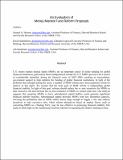| dc.contributor.author | Hanson, Samuel Gregory | |
| dc.contributor.author | Scharfstein, David Stuart | |
| dc.contributor.author | Sunderam, Aditya Vikram | |
| dc.date.accessioned | 2015-09-29T14:28:50Z | |
| dc.date.issued | 2015-09-29 | |
| dc.identifier.citation | Hanson, Samuel G., David S. Scharfstein, and Adi Sunderam. "An Evaluation of Money Market Fund Reform Proposals." IMF Economic Review (forthcoming). | en_US |
| dc.identifier.uri | http://nrs.harvard.edu/urn-3:HUL.InstRepos:22836593 | |
| dc.description.abstract | U.S. money market mutual funds (MMFs) are an important source of dollar funding for global financial institutions, particularly those headquartered outside the U.S. MMFs proved to be a source of considerable instability during the financial crisis of 2007–2009, resulting in extraordinary government support to help stabilize the funding of global financial institutions. In light of the problems that emerged during the crisis, a number of MMF reforms have been proposed, which we analyze in this paper. We assume that the main goal of MMF reform is safeguarding global financial stability. In light of this goal, reforms should reduce the ex ante incentives for MMFs to take excessive risk and increase the ex post resilience of MMFs to system-wide runs. Our analysis suggests that requiring MMFs to have subordinated capital buffers could generate significant financial stability benefits. Subordinated capital provides MMFs with loss absorption capacity, lowering the probability that an MMF suffers losses large enough to trigger a run, and reduces incentives to take excessive risks. Other reform alternatives based on market forces, such as converting MMFs to a floating NAV, may be less effective in protecting financial stability. Our analysis sheds light on the fundamental tensions inherent in regulating the shadow banking system. U.S. money market mutual funds (MMFs) are an important source of dollar funding for global financial institutions, particularly those headquartered outside the United States. MMFs proved to be a source of considerable instability during the financial crisis of 2007–2009, resulting in extraordinary government support to help stabilize the funding of global financial institutions. In light of the problems that emerged during the crisis, a number of MMF reforms have been proposed, which we analyze in this paper. We assume that the main goal of MMF reform is safeguarding global financial stability. In light of this goal, reforms should reduce the ex-ante incentives for MMFs to take excessive risk and increase the ex post resilience of MMFs to system-wide runs. Our analysis suggests that requiring MMFs to have subordinated capital buffers could generate significant financial stability benefits. Subordinated capital provides MMFs with loss absorption capacity, lowering the probability that an MMF suffers losses large enough to trigger a run and reduces incentives to take excessive risks. Other reform alternatives based on market forces, such as converting MMFs to a floating NAV, may be less effective in protecting financial stability. Our analysis sheds light on the fundamental tensions inherent in regulating the shadow banking system. | en_US |
| dc.language.iso | en_US | en_US |
| dc.relation.isversionof | http://www.palgrave-journals.com/imfer/index.html | en_US |
| dash.license | OAP | |
| dc.title | An Evaluation of Money Market Fund Reform Proposals | en_US |
| dc.type | Journal Article | en_US |
| dc.description.version | Author's Original | en_US |
| dc.relation.journal | IMF Economic Review | en_US |
| dash.depositing.author | Hanson, Samuel Gregory | |
| dc.date.available | 2015-09-29T14:28:50Z | |
| dash.contributor.affiliated | Scharfstein, David | |
| dash.contributor.affiliated | Sunderam, Aditya | |
| dash.contributor.affiliated | Hanson, Samuel | |


